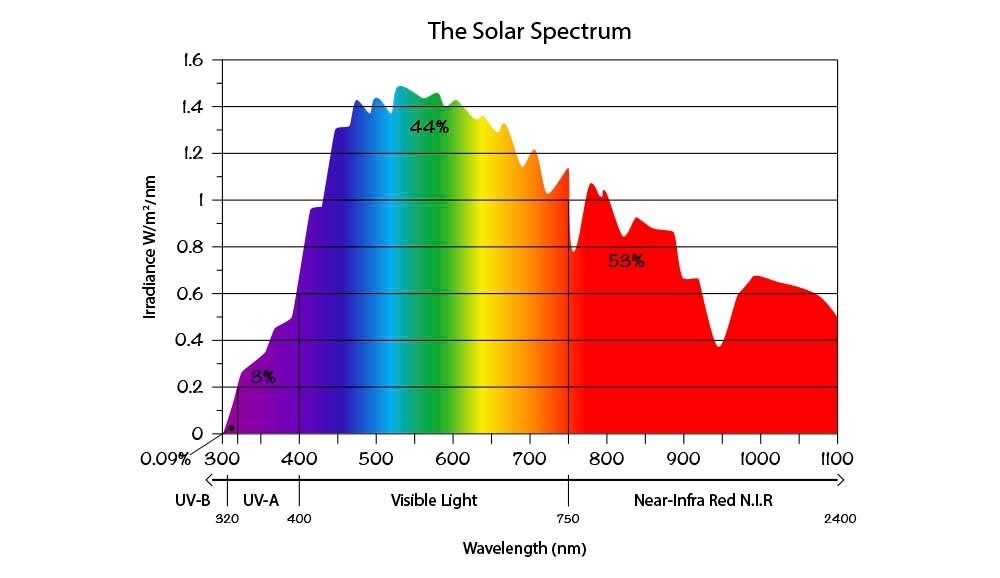The use of lightweight polycarbonate in shade structures has become synonymous with sun protection as the material does not allow harmful ultraviolet radiation (UVR) rays to be transmitted. To better understand the value of polycarbonate as a protective substrate against UVR in shade structures we need to better understand ultraviolet radiation.
What is ultraviolet radiation?
Ultraviolet radiation or UVR, is a form of non-ionizing radiation emitted by the sun, with about 10% of the sun’s radiation being generated in the form of ultraviolet. Ultraviolet is part of the electromagnetic spectrum with waves ranging from 10 to 400 nanometres, meaning they are shorter than visible light and longer than X-rays. While ultraviolet has some positive benefits, like assisting in the production of vitamin D, it is also the source of skin cancer and its exposure to eyes have been associated with cornea damage and cataract formation – all valid reasons to be sun smart and get excellent sun protection.
Thankfully, the shorter and most hazardous UV waves are absorbed by the atmosphere. At ground level, earth receives the range of 280-400 nanometres, which is further allocated to the higher Ultraviolet A (UVA) and lower Ultraviolet B (UVB) ranges The deadliest form of skin cancer, Melanoma, has been shown to correlate with the degree of UV exposure and while UV exposure also effects and degrades nonorganic materials like cars, any painted items will fade or crack over time depending on the amount of UV they are exposed to. If you are interested to read more about ultraviolet radiation and shade sails, click here.

Does polycarbonate block UV radiation?
Polycarbonate nearly blocks the entire UV spectrum, does not allow any UVR transmission and absorbs UVA and UVB rays. Its UVR blocking characteristics makes polycarbonate an ideal shade solution to protect against the sun’s harmful rays and a popular choice for roofing in both commercial and residential construction. A great application for a polycarbonate roof structure would be for covering a swimming pool, allowing swimmers to enjoy the natural light without the harmful UV concerns and swim all day without having to apply sunscreen.
Should polycarbonate itself be UV protected?
If polycarbonate absorbs all UV radiation, do you need to treat or protect the polycarbonate?
As polycarbonate absorbs all the harmful radiation it leads to yellowing or discoloration of the material over time, and eventually polycarbonate would lose its properties and break. It is therefore recommended to add a UV protection over polycarbonate to extend the lifespan of a polycarbonate structure. Reputable polycarbonate manufacturers apply a very thin UV protective layer to the sheets. This layer is invisible to the naked eye and does not impact the physical and optical characteristics of the material, while securing the performance of the sheet throughout its lifetime, even under harsh sunlight exposure conditions such as those found in Australia. When the polycarbonate is used in roofing a one-sided UV protection is enough.
Polycarbonate benefits
Polycarbonate is highly versatile in it is application and ideal for roofing, cladding, and skylights.
- Lightweight. Polycarbonate weighs half that of its glass equivalent which saves in shipping costs, handling, and installation.
- Durable. Polycarbonate is virtually indestructible, making it an ideal choice for protection from extreme weather conditions
- UVR protection. Polycarbonate does not allow any UVR transmission, while offering light transmission properties that are comparable to glass
- Warranty. Polycarbonate sheets are available with warranties for up to 15 years.
Summary
In summary, polycarbonate is an excellent material to protect people as well as non-organic items from UV exposure. However, when deciding to use polycarbonate as a shade structure solution it is recommended to have the polycarbonate sheets treated with a UV protection to extend its lifespan and save yourself money overall.

